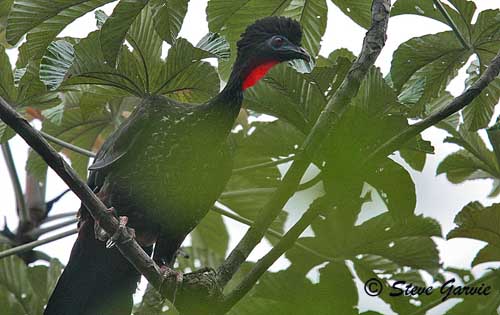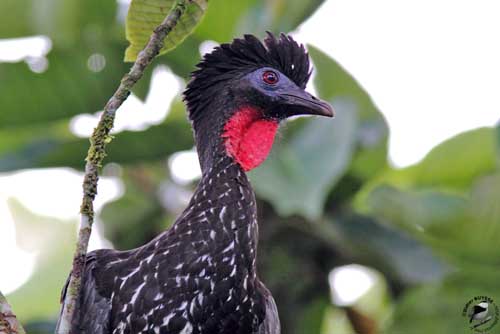
Fr: Pénélope panachée
All : Rostbauchguan
Esp : Pava Cojolita
Ital: Penelope crestata
Nd: Kuifsjakohoen
Sd: Tofsguan
Photographers:
Didier Buysse
Vision d’Oiseaux
Steve Garvie
RAINBIRDER Photo galleries
René Lortie
http://rlortie.ca/
Text by Nicole Bouglouan
Sources:
HANDBOOK OF THE BIRDS OF THE WORLD Vol 2 by Josep del Hoyo-Andrew Elliot-Jordi Sargatal - Lynx Edicions - ISBN: 8487334156
A GUIDE TO THE BIRDS OF MEXICO AND NORTHERN CENTRAL AMERICA by Steve N. G. Howell, Sophie Webb - Oxford University Press - ISBN: 0198540124
BirdLife International (BirdLife International)
Gbwf.org - Dedicated to the Aviculture and Conservation of the World’s Galliformes
Wikipedia, the free encyclopaedia
Crested Guan
Penelope purpurascens
Galliforme Order – Cracidae Family
BIOMETRICS:
Length: 72-91 cm
Weight: 1620-2430 g
DESCRIPTION:
The Crested Guan is the largest member of the genus Penelope. This is an arboreal species, often seen in small groups high in trees.
The adult has blackish-brown plumage overall, but it often appears mainly blackish. We can see a strong green gloss on upperparts, head, neck and breast, whereas rump and uppertail-coverts are more rufous. The long, broad tail is rufous with broad brown tip.
Underparts, neck and back are narrowly streaked and mottled white. Belly and undertail-coverts are rufous.
On the blackish-brown head, we can see an erectile bushy crest. The bare facial skin is dark blue-grey. There is an orange-red throat wattle.
The bill is black. The eyes are deep red. Strong legs and feet are dull reddish.

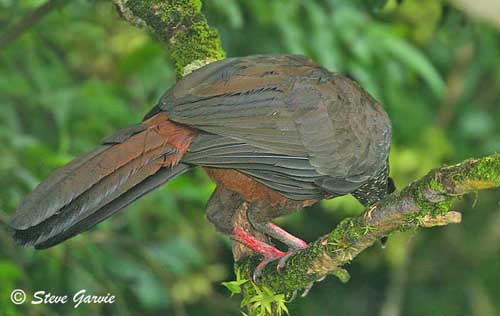
Both sexes are similar.
The juvenile has brownish eyes, not red. It has reduced or lacking throat wattle, and reduced white streaking. Its plumage is similar to that of adults, but with rufous-brown wash on wings and tail.
We can find three subspecies:
P.p. purpurascens (here described) is found in NW and NE Mexico, S to Honduras and Nicaragua.
P.p. aequatorialis occurs in S Honduras and Nicaragua, S to NW Colombia and SE Ecuador. It is similar to “brunnescens” but less rufous on rump and central rectrices.
P.p. brunnescens is found in N Colombia to E Venezuela. This one is more rufescent than nominate, and the narrow white streaked pattern is less distinct on underparts and absent on scapulars.
VOICE: SOUNDS BY XENO-CANTO
The Crested Guan gives loud honking and yelping calls, usually repeated in the early morning and the late afternoon “yoink yoink yoink…” or “kyeh-kyeh-kyeh…”. We can also hear a low gruff “urmmff”.
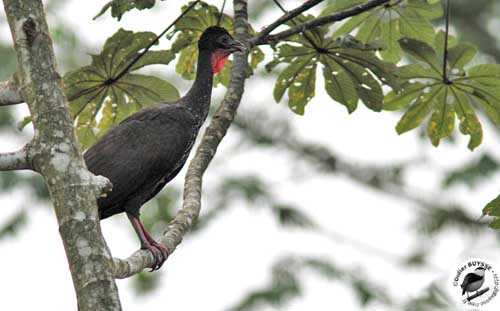
HABITAT:
The Crested Guan usually occurs in humid evergreen and semi deciduous forest, and locally in humid pine-oak forest.
This species is more visible in lowlands and hills below 1000 metres, but seasonally it may be found up to 2300-3000 metres of elevation.
It may locally venture into gallery-forest and in drier habitats, but it is absent from open savannas.
RANGE:
See above in “subspecies”
BEHAVIOUR:
The Crested Guan is often seen in pairs or in small groups and sometimes alone. This species usually occurs high in trees and rarely on the ground where it comes sometimes for drinking and to pick up fallen fruits or seeds.
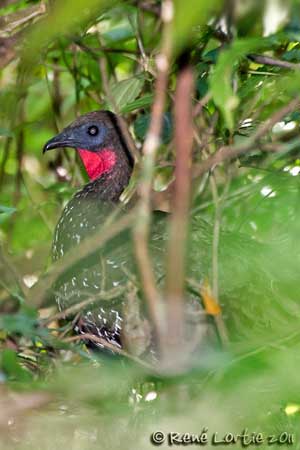
This species consumes berries, figs and other fruits from several plant species, and wild papayas too. It also takes other plant matter and occasionally insects.
It is considered a disperser due to numerous regurgitated seeds.
The guans of this family show plain and cryptic plumage that is ancestral in this family. The brighter parts of this plumage are only exhibited during courtship displays, and the most colourful parts are the facial skin and the throat wattle.
Like other guans, the Crested Guan produces a very loud noise while performing the characteristic wing-drumming or wing-whirring displays. This is due to the modification of the quills on three or four outermost primaries. During bowing displays, the narrow tip of the outermost primary is strongly incurved.
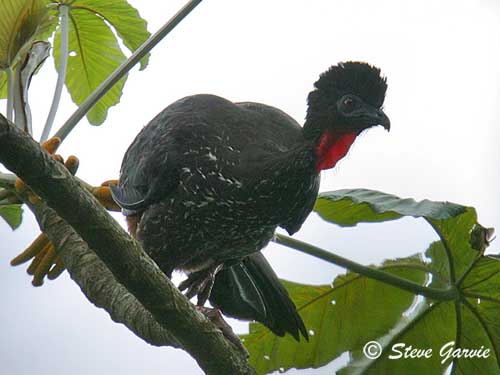
They sing and display usually in the dark, but the typical wing-whirring flight occurs very early in the morning, when it is still dark in the forest. The guan flies off the perch in tall tree, makes a short glides in the open and then, produces the wing-whir during about three seconds. This sound is produced by faster wingbeats, twice as fast as in normal flight. Then, it glides to another perch, usually lower down. This display is repeated several times, using different perches.
This display can be used to maintain the pair-bonds, and may also help in pair formation. Only the Crested Guan male performs this display during which the crest is erected and the red wattle is brighter.
This species is sedentary and only performs some seasonal altitudinal movements in mountainous areas.
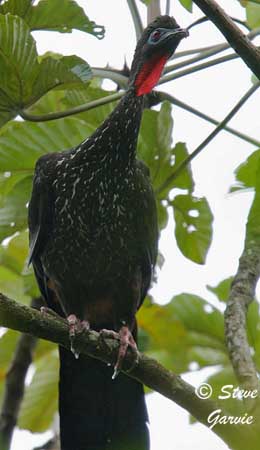
FLIGHT:
The Crested Guan performs laboured flight with typical rush of wings. It is able to glide over considerable distances across canyons.
REPRODUCTION:
The breeding season takes place between March and June in Mexico and in Costa Rica, between March and May in N Colombia and between March and July in Venezuela. In Panama, it occurs during the rainy season, with chicks visible in February/March.
Both sexes build the nest, a bulky platform made with sticks and twigs. The inner cup is lined with leaves. The nest is placed high in tree, or sometimes on top of stump.
The female lays 2-3 eggs. The downy chicks are chestnut above with buff and black mottling. Breast and flanks are reddish-brown, whereas belly is white. They are sexually mature at two years old.
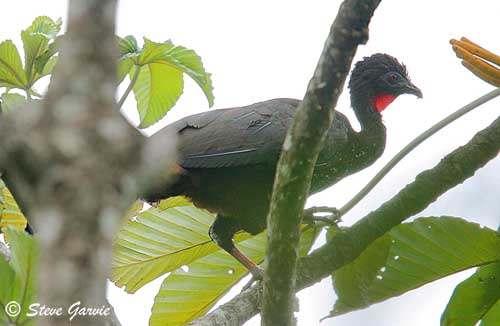
DIET:
The Crested Guan feeds on berries and various fruits such as figs, wild papayas, and those of several plant species such as Spondias, Bumalia, Guatteria, Chione and Cecropia. It also takes seeds, leaves, flowers and young shoots, and occasionally insects taken from the ground.
PROTECTION / THREATS / STATUS:
The Crested Guan is still fairly common in most parts of the range, in spite of hunting pressure and deforestation. However, populations are stable and the species is not currently threatened.
